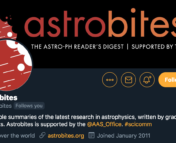Welcome to this guide to applying to astro postdocs! This is a 2-part series that will focus on (1) finding and (2) applying to astro/physics postdoctoral research opportunities.
A few caveats:
- Plenty of great resources for the postdoc application process already exist. (For example, this website by Dr. Taylor Hutchison is a fantastic resource with several great details that we won’t cover here!) This guide mostly consists of personal advice from us (Mia and Luna, the authors of this series)—however, everyone is different, and what worked for us might not be the best advice for you!
- Because we (the authors) only applied to postdocs in North America and Europe, our advice is heavily centered on these types of programs.
- Finally, remember that applying to postdocs comes with the same caveats as applying to college or graduate school: the level of success you achieve depends heavily on factors outside your control, and does not determine your value as a researcher or as a person.
Where can I find available postdocs?
There are a number of sites that post active job listings. These include the AAS Job Register and the EAS Job Directory (though check out this Twitter thread for more alternatives). You can also subscribe to mailing lists like the RAS JobList, or social media groups like the Early career astronomers & astrophysicists or the Early career planetary explorers groups on Facebook. Postdoc positions aren’t all posted at the same time, so we recommend that you check regularly at least a month before you start applying (e.g., for folks in the US planning to graduate in the spring and applying for US-based postdocs, start checking around September).
You can also find lists of postdocs people have applied for in previous years at the AstroBetter Rumor Mill. However, be careful! The Rumor Mill can be a useful resource during some parts of the application process (when trying to find postdocs, or when trying to decide between offers), but it can be detrimental during other parts of the process (particularly when waiting to hear about applications). Use it at your own risk!
Different kinds of astro postdocs
US-based postdocs
National fellowships
The US has a few big national fellowships for astronomers. Past a certain point, these fellowships are, more or less, a lottery—there are always far more qualified candidates than there are open spots. It never hurts to apply to as many fellowships as you’re eligible for, but not getting these fellowships says very little about your ability as a scientist.
- NSF AAPF: This is only available to US citizens or permanent residents, and there are some newly-enforced criteria about the kinds of research you can do (in particular, your proposal is not allowed to rely heavily on NASA-supported missions). It’s $100k/year for 3 years ($69k of that is your stipend, $31k is for research expenses and benefits). It has one of the earliest due dates (typically mid-October), so if you apply for it, you can sometimes modify the research proposal for all your other applications (though this isn’t always easy, due to the sheer length of the NSF application—see below).
- Note that the NSF AAPF is a lot of (mostly bureaucratic) work to apply for. It doesn’t require recommendation letters, but you do need a letter of support from your intended host institution, so you need to start contacting people really early. You will also have to write a 10-page (!!) research proposal that includes both Intellectual Merit (the scientific impact of your research) and Broader Impacts (outreach or public service that will affect the broader community) components, along with a ton of smaller statements.
- You also have to figure out the NSF FastLane system, which is a huge pain and frequently breaks on major due dates, so give yourself plenty of time to put everything together and submit.
- NASA Hubble: This is available to anyone applying to any of the qualified institutions (which include most places in the US); as part of the application, you rank up to 3 institutions as your proposed host institution. The stipend is adjusted annually over the course of the 3-year fellowship but is currently upwards of $71k, with an additional ~$15k for research expenses, plus healthcare benefits. The application asks for an 8-page research statement, divided into a “Summary of Previous Research” statement and a “Proposed Research” statement.
- While the NSF and the Hubble are among the most well-known astro fellowships in the US, there are other national fellowships! These include the NASA Postdoctoral Program (NPP), the NRAO Jansky (for radio astronomy), and the 51 Pegasi b (for planetary astronomy), to name a few.
Each of these fellowships have very specific criteria! They frequently have informational webinars as well as other resources (for example, the former Hubble Fellows have put together a bunch of incredible resources—including a repository of past successful applications, as well as a peer-editing program). Definitely do your research, and make use of as many resources as possible!
From a strategic perspective, it often makes sense to focus on these prize fellowships early on, since they’re due first. Then you can use the statements for these applications as a starting point, modifying them to fit more specific institutional or grant-based fellowships.
Institutional fellowships
Individual institutions often have their own fellowships. The stipend and duration for these institutional fellowships will vary: based on our (admittedly anecdotal) experience, typical annual salaries range from $60k to $90k, with durations of 3 to 5 years. Note that the oversubscription rate for these can be even higher than the national fellowships, so again: it never hurts to apply, but if you don’t get a “prestigious” fellowship, it’s absolutely not because you don’t deserve it.
Astro-specific institutional fellowships are typically comparable (in terms of stipend, duration, and benefits) to the national fellowships. There’s also a growing trend of research collaborations (not just universities) with their own fellowships, as well as non-astro-specific university fellowships. Each of these will have their own individual criteria (“scientific leadership” and “community impact” are common phrases)—read these carefully!
Grant-based postdocs
Postdoc fellowships allow you to have significant freedom in what you work on without tying you to a specific advisor or project. Grant-based postdocs are more constrained, in that you’re being hired to work with a specific advisor, typically on a specific research topic. Note, however, that fellowships are not always “better” than grant-based postdocs—for example, fellowships can actually be more complicated to manage (particularly with logistics, e.g., taxes and benefits). Unlike applications for fellowships, applications for these postdocs are typically much more tailored to the job description listed in the ad. Also, grant postdocs don’t always have fall application deadlines and function more on a rolling as-needed basis.
Non-US-based postdocs
Note: The authors of this series (Mia and Luna) only applied for postdocs in North America and Europe, so there’s some geographic bias here! Check out this Twitter thread by Floor Broekgaarden for a compilation of postdoc application resources from around the world.
(Inter)national fellowships
While less centralized than US-based national fellowships, many other countries (or even regions!) have equivalents. One famous multinational example is the Marie Skłodowska-Curie Fellowship covering all EU Member States and Horizon Europe Associated Countries, while something like the Canadian Institute for Theoretical Astrophysics (CITA) Fellowship covers institutions throughout Canada.
Unfortunately, there is no single database of all these opportunities (though many of the astro-specific ones will be on the AAS Job Register!). One way to seek these fellowships out is by targeting universities you might be interested in joining (your astro hero works there? they just came out with a fascinating paper? your friend told you they have excellent crumpets at journal club?) and searching their websites for listed fellowship opportunities. For instance, many UK universities (e.g., UCL) list (inter)national fellowships they are eligible to host!
A word of caution: the timelines for (inter)national fellowships can vary greatly: even if the funding agency’s deadline is in the fall, the department’s deadline for agreeing to host you might be in the summer! It’s best to start early and find the previous years’ internal and external deadlines to avoid being surprised.
Institutional fellowships
Many institutional fellowships function quite similarly to US-based ones: the stipend, duration, benefits, and focus will vary. Note that while most (but not all!) US-based fellowships do not have a teaching component, this expectation can be more common in other places. Teaching can be both a pro and a con: think about whether it works for you! Also, note that not all places will require letters of recommendation, or might require two (instead of the three typically required for US-based postdocs): if you don’t feel confident in all of your letters, this might be a way to let other parts of your application shine more brightly.
Grant-based postdocs
Echoing the advice for US-based grant postdocs, these might work better for you and be easier to navigate. The process for applying is similar to others outlined in this bite, but the timeline and terms of the postdoc (3 years? 2 years? 9 months??) can vary greatly from country to country!
Deciding where to apply
Now that you know what kinds of postdocs are out there, you need to figure out which ones you actually want to apply for. Here are some things to think about when making this list:
- Institutional research fit: Is a department more theory- or observation-heavy? Do they have the resources (telescope time, computational access) that you need to succeed in your research?
- Principal Investigator (PI) fit: Are there multiple people you’d be willing to collaborate with at the institution? Do you know any people at the institution already, and are they the kind of people you’d want to work with?
- Institutional climate fit: Outside of potential PIs, what’s the community like? Is there a strong postdoc community, or will you be isolated? Will you be able to find a support network outside your research group? This may be especially important if you have a marginalized identity!
- Location: Do you have a two-body problem or want to be close to family? Will cost of living be a major constraint for you? Will you be miserable if you’re too cold, or too hot, or too far away from [cities/nature/the ocean]? If you have a marginalized identity, will you feel safe and comfortable living in the area?
- Other constraints: Salary? Healthcare/childcare benefits? Taxes (doing taxes for research funds can be non-trivial)? Visas? There are plenty of logistics-related issues that are worth considering, and may even be deal breakers for you!
Although postdocs are shorter in duration than grad school, they still comprise a non-trivial amount of time to live and work in a place! If something is important to you, then it’s an important criterion to take into account.
Your postdoc application strategy will of course depend on you and your goals. That being said, we do recommend focusing your applications on postdocs that you feel are genuinely good fits for you. It can be tempting to write a generic application and send it to 40 different places, but what’s the point if you wouldn’t actually be happy at 30 out of those 40 places? Instead, consider spending your time on fewer applications that are more tailored.
In the next part of this series, we’ll talk about the actual postdoc application process.
This series was written by Mia de los Reyes and Luna Zagorac and was edited by Pratik Gandhi, Lina Kimmig, Ishan Misra, and Jenny Calahan.
Featured image credit: modified JWST image of the Carina Nebula (NASA, ESA, CSA, and STScI)




